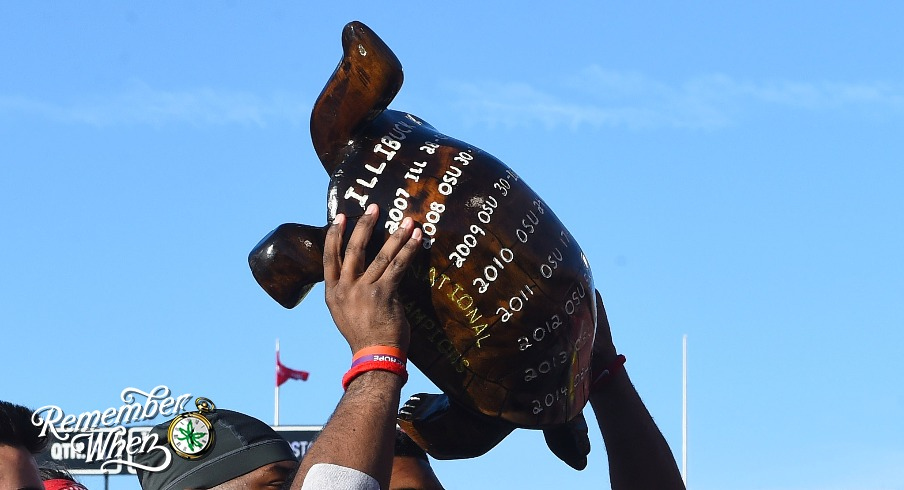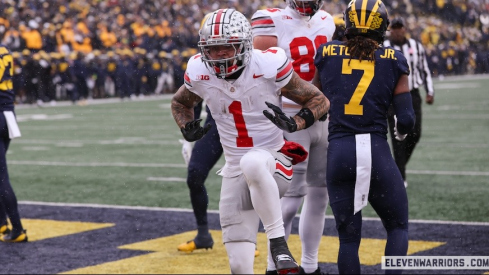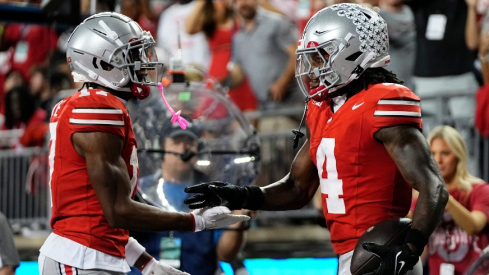Although the rivalry between Ohio State and Illinois technically had its first meeting in 1902, this year will serve as a 100th anniversary of sorts for the Illibuck trophy tradition when the schools meet on October 11th at Memorial Stadium in Champaign, IL.
A total of 10 wooden statues of the turtle have appeared in the century since the universities began marking their meetings with a trophy, each with the scores from the games carved into their shells to record the series' history. Many Buckeye and Illini fans alike already find themselves familiar with the fact that the first "trophy" between the football teams was in fact a live turtle by the name of Illibuck from which the rivalry gets its name.
What has become somewhat of a myth, however, is the mysterious legend of how the turtle passed away shortly after his introduction into college football lore. The sad irony of Illibuck's origin remains that the junior honorary societies of each school — Ohio State's Bucket and Dipper alongside Illinois' Atius-Sachem — chose the turtle as a symbol to represent the rivalry's expectation that it would last years upon years. Students estimated Illibuck as 50 years old when he began serving in his role, but he died not even a couple of full football seasons into the start of his tenure.
The undetermined nature of his death became a topic of speculation soon after its occurrence and well into the next century of the rivalry. This remains the case despite the fact that both The Lantern and The Daily Illini published extensive details about Illibuck during his lifetime and beyond, and both universities have put forth a remarkable effort to preserve their student journalism archives.

Illibuck weighed 25 lbs. — the largest among an assortment of 50 turtles available for purchase at a fish store in Columbus — though Bucket and Dipper reportedly chose him due to his "vicious" nature. Sachem agreed to the selection and its president humorously wired back "bring the turtle" to Bucket and Dipper. Ohio State lost the 1924 meeting in Champaign 7-0, and Sachem took custody of the animal.
Tragically for Illibuck, his quality of life would quickly spiral downhill in the care of the Fighting Illini. The university refused to house Illibuck at its zoology department contrary to a report from The Lantern two days following the 1924 game. The turtle refused to eat for extended periods, and although the creature can often survive for multiple months without consuming food, Sachem at one point wired back to Bucket and Dipper asking, "what do you feed a turtle?"
Worse yet, after Illinois' zoology folks turned him away, Illibuck would have to move to various problematic habitats around campus for the remainder of his life. Sachem confirmed he was living in a bathtub shortly before suggesting that the losing team have to keep the turtle as punishment rather than an honor. Bucket and Dipper laughed off this request, then ignored subsequent wires from Sachem — likely only further deteriorating the consideration for the care of the turtle.
Illinois beat Ohio State in Columbus once again in 1925 by a 14-9 final score, and so the caretaking duties once again fell upon the Illini for another year. Illibuck would never return to Columbus alive.
Now in the care of the Phi Kappa Sigma fraternity, the group of men tasked their pledges with taking Illibuck on "daily parades" and feeding him two meals of bread and meat per day before returning him to the frat house's bathtub. When Bucket and Dipper inquired about the condition of the turtle, Sachem told their Buckeye counterparts what they wanted to hear and relayed that Illibuck remained in “good condition and looks forward to his trip to Ohio.”
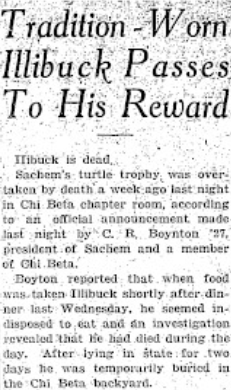
Six months later, on April 14th, 1926, Illibuck passed away at the Chi Beta house and the chapter buried him in their backyard. The Sachem president — a Chi Beta member — announced his death to the university a week later and The Daily Illini published news of the turtle's demise the following day. He had last appeared in public for the university's Axe-Grinders Ball in December, which made the specific circumstances of his death uncertain and a subject of speculation for years to come.
Given the knowledge that Illibuck had spent much of the final years of his life in bathtubs, a myth surrounding his death emerged that the turtle had perhaps died of alcohol poisoning at the hands of misguided fraternity drunks. Worse yet, some even suggested that he had outright drowned in a bathtub filled with liquor as some sort of crude swimming exercise or that the Illini had eaten him as turtle soup given the burden he had become for his caretakers.
The myth became so convoluted that sometimes his death would be mistakenly attributed to Bucket and Dipper as opposed to Sachem, a claim supposedly believed even by members themselves of the former. However, the previously-cited report from The Daily Illini confirms that Illibuck passed away in Champaign after serving as the winning symbol for two Illini victories.
Thus, the 1926 game became a crucial one for the honor of the turtle's legacy. Ohio State would rise to the occasion.
As farfetched as it may seem to modern day college football fans, at this point in the sport's history, the rivalry between the Buckeyes and Fighting Illini actually held greater prestige than that of OSU's with Michigan. Fittingly, Ohio State and Illinois had made a habit of meeting for their final game of the season in November, a precedent that would not shift in The Game's favor until 1935.
Illinois won both battles for the live Illibuck largely on the back of Red Grange, the halfback also known as "The Galloping Ghost" named by ESPN in 2008 as the greatest college football player of all time. Shortly after the 1925 game against Ohio State, Grange declared his intent to sign with the NFL's Chicago Bears.
Thus, the opportunity emerged for the Buckeyes to avenge not only three straight losses in the series with the Fighting Illini, but also the death of their beloved reptile. Further fueled by a defeat to Michigan that spoiled a potential undefeated season the week prior, Ohio State traveled to Champaign with a 6-1 record under the tutelage of head coach John Wilce. Illinois owned an identical record to that point in the season — with their own loss also at the hands of the Wolverines — and had yet to lose at home.
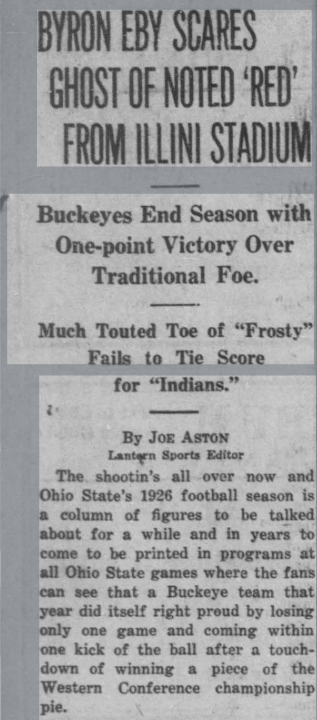
According to The Lantern's recap of the afternoon, the Memorial Stadium field found itself under a thin layer of late-November freeze and snow, further compromised by the typical prairie winds of downstate Illinois. Chillicothe, OH native Byron Eby took Freddy Grim's place as starting running back for the Buckeyes midway through the second quarter, and navigated the Illinois defense "as if he were a greased channel swimmer" on his way to scoring Ohio State's only touchdown of the game on a 12-play drive from midfield.
Meanwhile, on the other side of the ball, the Buckeye defense made the most of the field conditions by holding the Fighting Illini to zero points on the day until the final full possession of the game. The Lantern's sports editor Joe Aston described the overall effort as though "Dr. Wilce's team had reached perfection in football."
Despite that assertation, had such precision actually taken place, the final score could have ended up much wider. Aston noted that the Buckeyes consistently gained chunks of five to 15 yards on offense largely via off tackle runs, but still squandered several scoring chances. Thankfully, Illinois struggled to materialize any offensive production for most of the afternoon to the chagrin of the 35,000 fans in attendance.
Illinois finally reached the endzone towards the end of regulation thanks to a passing attack that caught fire down the stretch. However, frigid conditions and the northwest wind that day made for a nonoptimal kicking environment. "Frosty" Peters — shortly after making a crucial catch of at least 30 yards for the Fighting Illini that flipped the field on the final drive — entered the game for the tying drop kick try. At that point, "The Frozen Fireman" had otherwise served as Illinois' best offensive player on the day.
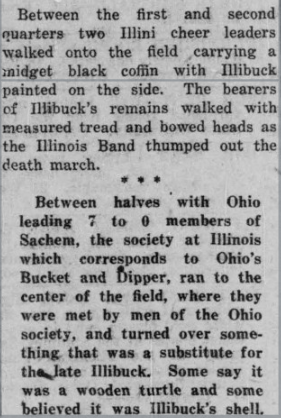
But the spirit of Illibuck made itself apparent shortly after the Illini scored. Earlier on during the contest between the first and second quarters, two Illini cheerleaders walked a "midget black coffin" onto the field with an image of a turtle painted on the side as the Fighting Illini marching band belted out a death march.
Now with Illibuck's remains present and memory freshly ingrained in the minds of those in attendance seven months following his death on the Illinois campus, the football gods struck back in a karmic sense against the sins of the Fighting Illini. Peters missed his drop kick, and two snaps of the football later, Ohio State had defeated Illinois for the first time since 1922 by a final score of 7-6. After the game, all Peters could say was, "I just missed it, damn it!"
The legacy of Illibuck had found itself avenged, but the bad blood in the rivalry hardly died with the reptile. The Buckeyes would continue to face the Fighting Illini several times over the next near-century, ultimately taking a commanding 68-30-4 lead in the series. The two schools continue to carve the results of each game into wooden replicas of the ill-fated animal's shell, while Illibuck indubitably smiles with a snarl down from turtle heaven at each Buckeye victory.
Illinois will seek its first win in the rivalry since 2007 — and first at home since 1991 — when Ohio State heads off to Memorial Stadium in October to face its rival for the first time since 2017.
